Viking 1
|
Viking orbiter | |
| Mission type | orbiter and lander |
|---|---|
| Operator | NASA |
| COSPAR ID |
Orbiter:1975-075A Lander:1975-075C |
| SATCAT № |
Orbiter:8108 Lander:9024 |
| Website | Viking Project Information |
| Mission duration |
orbiter:1846 days (1797 sols) lander:2306 days (2245 sol) |
| Spacecraft properties | |
| Manufacturer |
Orbiter:NASA JPL Lander:Martin Marietta |
| Launch mass |
Orbiter:883 kg (1,947 lb) Lander:572 kg (1,261 lb) |
| Power |
Orbiter:620 W Lander:70 W |
| Start of mission | |
| Launch date | 21:22, August 20, 1975[1][2] |
| Rocket | Titan IIIE/Centaur |
| End of mission | |
| Last contact | November 13, 1982 |
| Orbital parameters | |
| Reference system | Areocentric |
| Mars orbiter | |
| Spacecraft component | Viking 1 Orbiter |
| Orbital insertion | June 19, 1976[1][3] |
| Orbit parameters | |
| Periareion | 320 km (200 mi) |
| Apoareion | 56,000 km (35,000 mi) |
| Inclination | 39.3° |
| Mars lander | |
| Spacecraft component | Viking 1 Lander |
| Landing date |
July 20, 1976[1] 11:53:06 (MSD 36455 00:34 AMT) |
| Landing site | 22°29′N 49°58′W / 22.48°N 49.97°W[1] |
Viking 1 was the first of two spacecraft (along with Viking 2) sent to Mars as part of NASA's Viking program.[1] On July 20, 1976, it became the first spacecraft to land successfully on Mars and perform its mission.[4] Viking 1 held the record for the longest Mars surface mission of 2307 days[1] or 2245 sols[1] until that record was broken by Opportunity on May 19, 2010.[5]
Mission
Following launch using a Titan/Centaur launch vehicle on August 20, 1975, and a 10-month cruise to Mars, the orbiter began returning global images of Mars about 5 days before orbit insertion. The Viking 1 Orbiter was inserted into Mars orbit on June 19, 1976, and trimmed to a 1513 x 33,000 km, 24.66 h site certification orbit on June 21. Landing on Mars was planned for July 4, 1976, the United States Bicentennial, but imaging of the primary landing site showed it was too rough for a safe landing. The landing was delayed until a safer site was found. The lander separated from the orbiter on July 20 08:51 UTC and landed at 11:53:06 UTC. It was the first attempt by the United States at landing on Mars.
Orbiter
The instruments of the orbiter consisted of two vidicon cameras for imaging (VIS), an infrared spectrometer for water vapor mapping (MAWD) and infrared radiometers for thermal mapping (IRTM).[6] The orbiter primary mission ended at the beginning of solar conjunction on November 5, 1976. The extended mission commenced on December 14, 1976, after solar conjunction. Operations included close approaches to Phobos in February 1977. The periapsis was reduced to 300 km on March 11, 1977. Minor orbit adjustments were done occasionally over the course of the mission, primarily to change the walk rate — the rate at which the areocentric longitude changed with each orbit, and the periapsis was raised to 357 km on July 20, 1979. On August 7, 1980, Viking 1 Orbiter was running low on attitude control gas and its orbit was raised from 357 × 33943 km to 320 × 56000 km to prevent impact with Mars and possible contamination until the year 2019. Operations were terminated on August 17, 1980, after 1485 orbits.
Lander
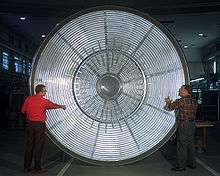

The lander and its aeroshell separated from the orbiter on July 20 at 08:51 UTC. At the time of separation, the lander was orbiting at about 5 kilometres per second (3.1 miles per second). The aeroshell's retrorockets fired to begin the lander de-orbit maneuver. After a few hours at about 300 kilometres (190 miles) altitude, the lander was reoriented for atmospheric entry. The aeroshell with its ablative heat shield slowed the craft as it plunged through the atmosphere. During this time, entry science experiments were performed by using a retarding potential analyzer, a mass spectrometer, as well as pressure, temperature, and density sensors.[6] At 6 km (3.7 mi) altitude, traveling at about 250 metres per second (820 feet per second), the 16 m diameter lander parachutes deployed. Seven seconds later the aeroshell was jettisoned, and 8 seconds after that the three lander legs were extended. In 45 seconds the parachute had slowed the lander to 60 metres per second (200 feet per second). At 1.5 km (0.93 mi) altitude, retrorockets on the lander itself were ignited and, 40 seconds later at about 2.4 m/s (7.9 ft/s), the lander arrived on Mars with a relatively light jolt. The legs had honeycomb aluminum shock absorbers to soften the landing.[6]
The landing rockets used an 18-nozzle design to spread the hydrogen and nitrogen exhaust over a large area. NASA calculated that this approach would mean that the surface would not be heated by more than one 1°C (1.8°F), and that it would move no more than 1 millimetre (0.039 inches) of surface material. Since most of Viking's experiments focused on the surface material a more straightforward design would not have served.
The Viking 1 Lander touched down in western Chryse Planitia ("Golden Plain") at 22°41′49″N 48°13′19″W / 22.697°N 48.222°W at a reference altitude of −2.69 kilometres (−1.67 mi) relative to a reference ellipsoid with an equatorial radius of 3,397 kilometres (2,111 mi) and a flatness of 0.0105 (22.480° N, 47.967° W planetographic) at 11:53:06 UT (16:13 local Mars time). Approximately 22 kilograms (49 lb) of propellants were left at landing.
Transmission of the first surface image began 25 seconds after landing and took about 4 minutes (see below). During these minutes the lander activated itself. It erected a high-gain antenna pointed toward Earth for direct communication and deployed a meteorology boom mounted with sensors. In the next 7 minutes the second picture of the 300° panoramic scene (displayed below) was taken.[7] On the day after the landing the first color picture of the surface of Mars (displayed below) was taken. The seismometer failed to uncage, and a sampler arm locking pin was stuck and took five days to shake out. Otherwise, all experiments functioned normally. The lander had two means of returning data to Earth: a relay link up to the orbiter and back, and by using a direct link to Earth. The data capacity of the relay link was about 10 times higher than the direct link.[6]
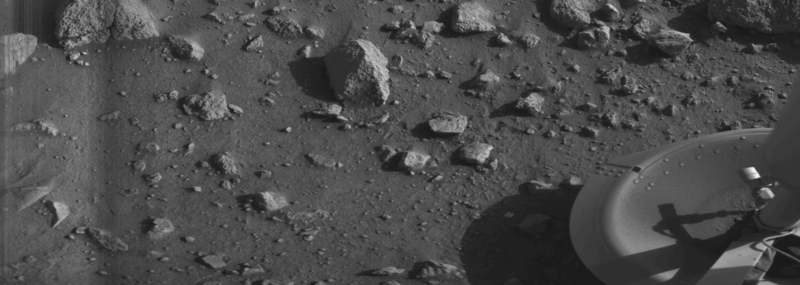
The lander had two facsimile cameras, three analyses for metabolism, growth or photosyntheses, a gas chromatograph-mass spectrometer (GCMS), an x-ray fluorescence spectrometer, pressure, temperature and wind velocity sensors, a three-axis seismometer, a magnet on a sampler observed by the cameras, and various engineering sensors.[6]
The Viking 1 Lander was named the Thomas Mutch Memorial Station in January 1982 in honor of the leader of the Viking imaging team. The lander operated for 2245 sols (about 2306 Earth days or 6 years) until November 11, 1982, (sol 2600), when a faulty command sent by ground control resulted in loss of contact. The command was intended to uplink new battery charging software to improve the lander's deteriorating battery capacity, but it inadvertently overwrote data used by the antenna pointing software. Attempts to contact the lander during the next four months, based on the presumed antenna position, were unsuccessful.[8] In 2006 the Viking 1 lander was imaged on the Martian surface by the Mars Reconnaissance Orbiter.[9]
Mission results
Search for life
Viking carried a biology experiment whose purpose was to look for evidence of life. The Viking spacecraft biological experiments weighed 15.5 kg (34 lbs) and consisted of three subsystems: the pyrolytic release experiment (PR), the labeled release experiment (LR), and the gas exchange experiment (GEX). In addition, independent of the biology experiments, Viking carried a gas chromatograph/mass spectrometer (GCMS) that could measure the composition and abundance of organic compounds in the martian soil.[10] The results were surprising and interesting: the GCMS gave a negative result; the PR gave a negative result, the GEX gave a negative result, and the LR gave a positive result.[11] Viking scientist Patricia Straat stated in 2009, "Our (LR) experiment was a definite positive response for life, but a lot of people have claimed that it was a false positive for a variety of reasons."[12] Most scientists now believe that the data were due to inorganic chemical reactions of the soil; however, this view may be changing after the recent discovery of near-surface ice near the Viking landing zone.[13] Some scientists still believe the results were due to living reactions. No organic chemicals were found in the soil. However, dry areas of Antarctica do not have detectable organic compounds either, but they have organisms living in the rocks.[14] Mars has almost no ozone layer, unlike the Earth, so UV light sterilizes the surface and produces highly reactive chemicals such as peroxides that would oxidize any organic chemicals.[15] The Phoenix Lander discovered the chemical perchlorate in the Martian soil. Perchlorate is a strong oxidant so it may have destroyed any organic matter on the surface.[16] If it is widespread on Mars, carbon-based life would be difficult at the soil surface.
First panorama by Viking 1 lander

Viking 1 image gallery
 Launch of the Viking 1 probe (August 20, 1975).
Launch of the Viking 1 probe (August 20, 1975). First image by the Viking 1 lander from the surface of Mars, showing lander's footpad.
First image by the Viking 1 lander from the surface of Mars, showing lander's footpad. Viking 1 lander image of a martian sunset over Chryse Planitia.
Viking 1 lander image of a martian sunset over Chryse Planitia.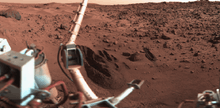 Trenches dug by soil sampler device.
Trenches dug by soil sampler device. First color image taken by the Viking 1 lander (July 21, 1976).
First color image taken by the Viking 1 lander (July 21, 1976).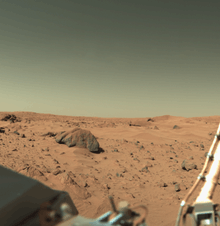 Viking 1 lander site (February 11, 1978).
Viking 1 lander site (February 11, 1978). Viking 1 lander taken by Mars Reconnaissance Orbiter (December 2006).
Viking 1 lander taken by Mars Reconnaissance Orbiter (December 2006). Dunes and large boulder. Pole in the center is an instrument boom.
Dunes and large boulder. Pole in the center is an instrument boom..jpg) Viking Lander 1 Camera 2 SKY AT SUNRISE (Low Resolution Color) Sol 379 07:50
Viking Lander 1 Camera 2 SKY AT SUNRISE (Low Resolution Color) Sol 379 07:50
Test of general relativity

Gravitational time dilation is a phenomenon predicted by the theory of General Relativity whereby time passes more slowly in regions of lower gravitational potential. Scientists used the lander to test this hypothesis, by sending radio signals to the lander on Mars, and instructing the lander to send back signals, in cases which sometimes included the signal passing close to the Sun. Scientists found that the observed Shapiro delays of the signals matched the predictions of General Relativity.[17]
Orbiter shots
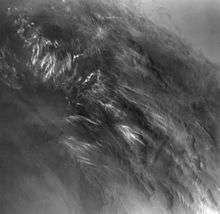
 Streamlined islands in Lunae Palus quadrangle.
Streamlined islands in Lunae Palus quadrangle.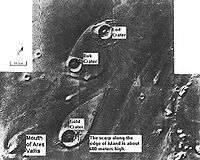 Tear-drop shaped islands at Oxia Palus quadrangle.
Tear-drop shaped islands at Oxia Palus quadrangle.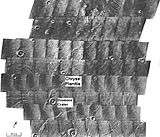 Scour patterns located in Lunae Palus quadrangle.
Scour patterns located in Lunae Palus quadrangle.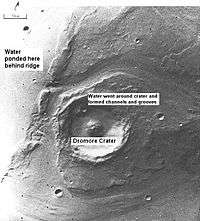 Lunae Palus quadrangle was eroded by large amounts of liquid water.
Lunae Palus quadrangle was eroded by large amounts of liquid water.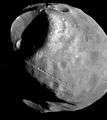 Phobos, a mosaic of images taken in 1978.
Phobos, a mosaic of images taken in 1978.
Lander location
See also
References
- 1 2 3 4 5 6 7 Williams, David R. Dr. (December 18, 2006). "Viking Mission to Mars". NASA. Retrieved February 2, 2014.
- ↑ "Viking 1". NASA.
- ↑ Nelson, Jon. "Viking 1". NASA. Retrieved February 2, 2014.
- ↑ The Soviet Union's Mars 3 landed successfully on December 2, 1971 but stopped transmitting after 14.5 seconds.
- ↑ http://mars.nasa.gov/mer/newsroom/pressreleases/20100519a.html
- 1 2 3 4 5 Soffen, G.A.; Snyder, C.W. (August 1976). "The First Viking Mission to Mars". Science, New Series. 193 (4255): 759–766. doi:10.1126/science.193.4255.759. JSTOR 1742875.
- ↑ Mutch, T.A.; et al. (August 1976). "The Surface of Mars: The View from the Viking 1 Lander". Science, New Series. 193 (4255): 791–801. doi:10.1126/science.193.4255.791. JSTOR 1742881.
- ↑ D. J. Mudgway (1983). "Telecommunications and Data Acquisition Systems Support for the Viking 1975 Mission to Mars" (PDF). NASA Jet Propulsion Laboratory. Retrieved 2009-06-22.
- ↑ "NASA Mars Orbiter Photographs Spirit and Vikings on the Ground". NASA. 2006. Retrieved 2011-07-20.
- ↑ Malin Space Science Systems Archived October 20, 2014, at the Wayback Machine.
- ↑ Viking Data May Hide New Evidence For Life. Barry E. DiGregorio, July 16, 2000.
- ↑ Viking 2 Likely Came Close to Finding H2O. Archived September 30, 2009, at the Wayback Machine. Irene Klotz, Discovery News, September 28, 2009.
- ↑ Stuurman, C.M.; Osinski, G.R.; Holt, J.W.; Levy, J.S.; Brothers, T.C.; Kerrigan, M.; Campbell, B.A. (September 28, 2016). "SHARAD detection and characterization of subsurface water ice deposits in Utopia Planitia, Mars". Geophysical Research Letters. 43 (18): 9484–9491.
- ↑ Friedmann, E. 1982. Endolithic Microorganisms in the Antarctic Cold Desert. Science: 215. 1045–1052.
- ↑ Hartmann, W. 2003. A Traveler's Guide to Mars. Workman Publishing. NY NY.
- ↑ Alien Rumors Quelled as NASA Announces Phoenix Perchlorate Discovery. Archived September 4, 2010, at the Wayback Machine. A.J.S. Rayl, August 6, 2008.
- ↑ Reasenberg, R. D.; Shapiro, I. I.; MacNeil, P. E.; Goldstein, R. B.; Breidenthal, J. C.; Brenkle, J. P.; et al. (December 1979). "Viking relativity experiment - Verification of signal retardation by solar gravity". Astrophysical Journal Letters. 234: L219–L221. Bibcode:1979ApJ...234L.219R. doi:10.1086/183144.



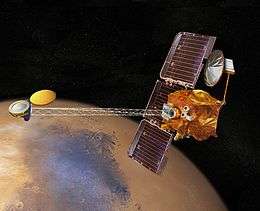
.jpg)
.jpg)